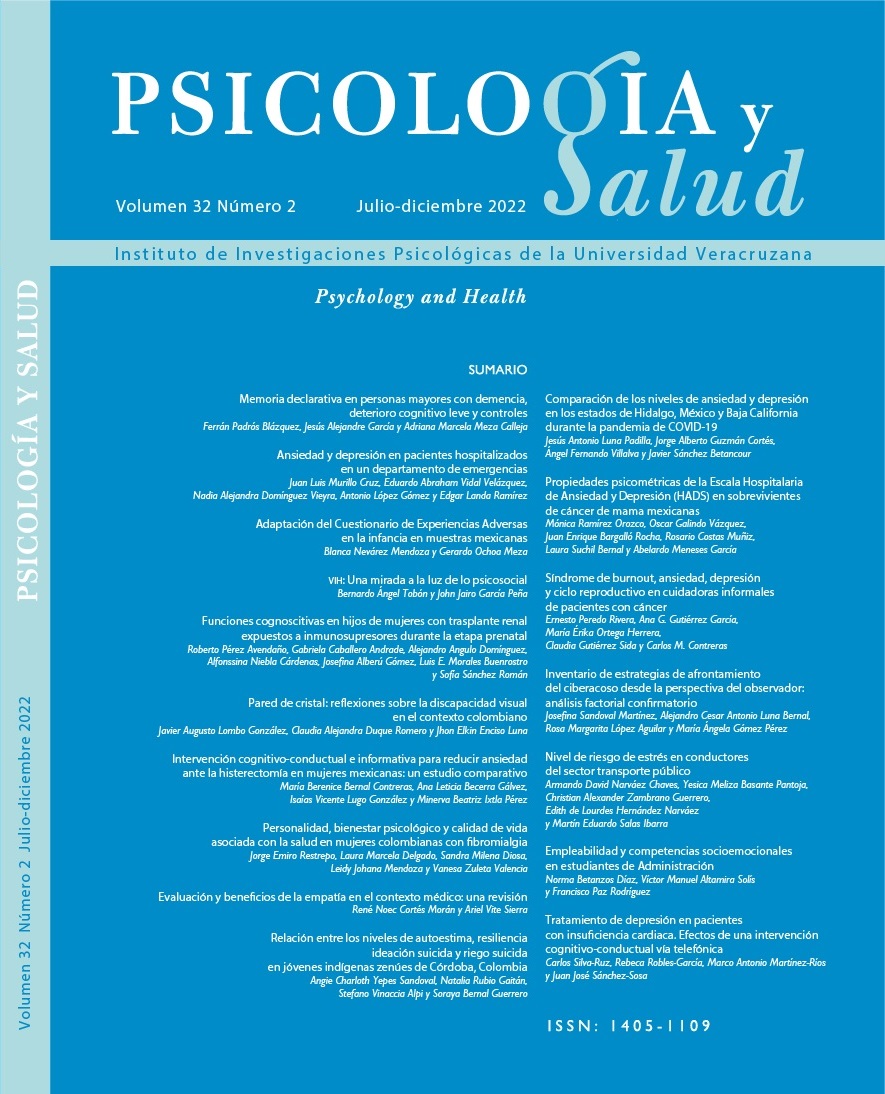Abstract
Background. Hysterectomy causes fear, worry, and anxiety, resulting in a negative effect on the hospital care process and complications after surgery. Different psychological interventions have been developed for these effects, exploring if those women who undergo this procedure have better pre and post-operative control. Some interventions may resort to the techniques of cognitive-behavioral therapy or traditional interventions based on information. Objective. The present study aimed at assessing the effect of a cognitive-behavioral program, compared to an informative intervention on anxiety levels prior to hysterectomy in a group of women from a tertiary care hospital in Mexico City. Method. Twenty-four women participated: 12 in the experimental group (EG), and 12 in the comparative group (CG), with a mean age of 46.25 years. Results. The main findings revealed lower anxiety levels before surgery in the EG group, with an anxiety level in the norm and above the norm in CG participants. Both interventions showed positive effects in reducing anxiety before surgery, with a more noticeable impact in the EG group and moderate in the CG. Discussion. We conclude that cognitive-behavioral therapy is more effective than providing only information in reducing anxiety in this type of hospitalized surgical patients.
References
Álvarez G., M. (2014). Ansiedad: evaluación, diagnóstico e intervención preoperatoria. Revista Mexicana de Anestesiología, 37, 152-154.
Ayyadhah, A. (2014). Reducing anxiety in preoperative patients: a systematic review. British Journal of Nursing, 23(7), 387-393. Doi: 10.12968/bjon.2014.23.7.387.
Becerra, A., Reynoso, L., García, F. y Ramírez, A. (2016). Intervención cognitivo-conductual para el control de ansiedad ante la biopsia incisional en pacientes con cáncer de mama. Psicooncología, 13(1), 85-99. Doi: 10.5209/revPSIC.2016.v13. n1.52489.
Beresnevaité, M., Benetis, R., Taylor, G., Rašinskienė, S., Stankus, A. y Kinduris, S. (2016). Impact of a cognitive behavioral intervention of health-related quality of life and general heart rate variability in patients following cardiac surgery: an effectiveness study. Psychosomatics, 57(6), 605-615. Doi: 10.1016/j.psym.2016.04.004.
Carapia, A., Mejía, G., Nacif, L. y Hernández, N. (2011). Efecto de la intervención psicológica sobre la ansiedad preoperatoria. Revista Mexicana de Anestesiología, 34(4), 260-263.
Carr, E., Brockbank, K., Allen, S. y Strike, P. (2006). Patterns and frequency of anxiety in women undergoing gynecological surgery. Journal of Clinical Nursing, 15, 341-352. Doi: 10.1111/j.1365-2702.2006.01285.x.
Cázares de L., F., Vinaccia, S., Quiceno, J. y Montoya, B. (2016). Preparación psicológica para la intervención quirúrgica: Revisión sistemática de la literatura. Psychologia, 10(2), 73-85.
Cohen, J. (1988). Statistical power analysis for the behavioral sciences. Hillsdale, NJ: Erlbaum.
Colegio Americano de Obstetras y Ginecólogos (2015). La histerectomía [Folleto informativo].
Devine, E. (1992). Effects of psychoeducational care for adult surgical patients: a meta-analysis of 191 studies. Patient Education and Counseling, 19, 129-142. Doi: 10.1016/0738-3991(92)90193-M.
Deza C., K. (2013). Efectividad del programa “Cuidado preoperatorio de histerectomía” en el nivel de ansiedad de la mujer, Servicio de ginecología del H.R.D.T Trujillo. Cientifi-k, 1(2), 25-31.
Díaz-Guerrero, R. y Spielberger, C. (1975). IDARE Inventario de ansiedad: rasgo-estado. México: El Manual Moderno.
Erdoğan, E., Demir, S., Belkıs, B., Çalışkan, C. y Gülsüm, N. (2019). Effect of psychological care given to the women who underwent hysterectomy before and after the surgery on depressive symptoms, anxiety and the body image levels. Journal of Obstetrics and Gynaecology, 40(7), 981-987. Doi: 10.1080/01443615.2019.1678574.
Ergen, E., Kemal, Y., Kılıççı, C., Abide, C. y Ayas, S. (2019). Does minimally invasive surgery reduce anxiety? Journal of the Turkish-German Gynecological Association, 20, 142-146. Doi: 10.4274/jtgga.galenos.2018.2018.0073.
Field, A. (2009). Discovering statistics using SPSS: sex, drugs and rock’n roll. London: SAGE Publications, Ltd.
Gillies, M.A. y Baldwin, F.J. (2001). Do patient information booklets increase perioperative anxiety? European Journal of Anaesthesiology, 18(9), 620-622. Doi: 10.1046/j.1365-2346.2001.00891.x.
Hammer, A., Rositch, A., Kahlert, J., Gravitt, P., Blaakaer, J. y Sogaard, M. (2015). Global epidemiology of hysterectomy: possible impact of gynecological cancer rates. American Journal of Obstetrics and Gynecology, 213(1), 23-29. Doi: 10.1016/j.ajog.2015.02.019.
Jarmoszewicz, K., Nowicka-Sauer, K., Zemła, A. y Beta, S. (2020). Factors associated with high preoperative anxiety: results from cluster analysis. World Journal of Surgery, 44(7), 2162-2169. Doi: 10.1007/s00268-020-05453-x.
Kerlinger, F. y Lee, H. (2001). Investigación del comportamiento. Métodos de investigación en ciencias sociales. México: McGraw-Hill.
Méndez, I., Namihira, D., Moreno, L. y Sosa, J. (2001). El protocolo de investigación. Lineamientos para su elaboración y análisis. México: Trillas.
Miller, S., Sohl, J., Schnur, J., Margolies, L., Bolno, J., Szabo, J., Herman, G. y Montgomery, G. (2014). Pre-biopsy psychological factors predict patient biopsy experience. International Journal of Behavior Medicine, 21, 144-148. Doi: 10.1007/s12529-012-9274-x.
Montgomery, G., David, D., Goldfarb, A., Silverstein, J., Weltz, C., Birk, J. y Bovbjerg, D. (2003). Sources of anticipatory distress among breast surgery patients. Journal of Behavioral Medicine, 26(2), 153-164. Doi: 10.1023/A:1023034706298.
Orane, A. (2016). Sangrado uterino anormal. Revista Clínica de la Escuela de Medicina UCR-HSJD, 6(6), 11-20.
Palma, S. (2013). Endometriosis. Revista Médica de Costa Rica y Centroamérica, 70(606), 281-288.
Quintero, A., Yasnó, D., Riveros, O., Castillo, J. y Borráez, B. (2017). Ansiedad en el paciente prequirúrgico: un problema que nos afecta a todos. Revista Colombiana de Cirugía, 32, 115-120.
Radosa, J., Meyberg-Solomayer, G., Kastl, C., Radosa, C., Mavrova, R., Gäber, S., Baum, S. y Radosa, M. (2014). Influences of different hysterectomy techniques on patients’ postoperative sexual function and quality of life. Journal of Sexual Medicine, 11(9), 2342-2350. Doi: 10.1111/jsm.12623.
Ramdhan, R., Loukas, M. y Tubbs, S. (2017). Anatomical complications of hysterectomy: a review. Clinical Anatomy, 30, 946-952. Doi: 10.1002/ca.22962.
Tatrow, K. y Montgomery, G. (2006). Cognitive behavioral therapy techniques for distress and pain in breast cancer patients: a meta-analysis. Journal of Behavior Medicine, 29(1), 17-27. Doi: 10.1007/s10865-005-9036-1.
Wongkietkachorn, A., Wongkietkachorn, N. y Rhunsiri, P. (2018). Preoperative needs-based education to reduce anxiety, increase satisfaction, and decrease time spent in day surgery: a randomized controlled trial. World Journal of Surgery, 42(3), 666-674. Doi: 10.1007/s00268-017-4207-0.
Yaman, Y., Gok, H. y Sevcan, O. (2019). Discharge education interventions to reduce anxiety and depression in cardiac surgery patients: a randomized controlled study. Journal of Perianesthesia Nursing, 35(2), 1-8. Doi: 10.1016/j.jopan.2019.08.012.

